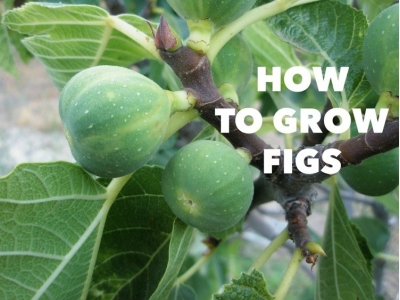Growing Figs

Fig trees are an often-overlooked backyard tree that produces very tasty, high-nutrition fruits. In many parts of the world, figs are a staple food.
LOCATIONS WHERE FIGS CAN BE GROWN
Figs will grow in areas rated Zone 8 or higher. That’s a limited area in the U.S., though some indoor dwarf varieties (that are generally low-bearing, but pretty) are also available. Figs require very warm weather and lots of sunlight and cannot withstand long winters.
SITE SELECTION FOR FIG TREES
Most fig varieties are indifferent to soil, though lighter, rich soils will obviously grow stronger trees faster. So long as there is enough soil depth (5+ feet) and drainage for floods, figs will do well. They prefer a pH of 6.0-6.5 and have no problem with some salinity. If the figs are to be dried, soil with a fair amount of lime is often preferred.
PLANTING FIGS
Although figs can be raised from seed, most are propagated by cuttings or greenhouse germination. Trees should be about 13 feet apart (though this does vary by variety) and trained to grow upright. Shading of young plants for part of the day is usually recommended until they are established. Fertilize at a 10-30-10 ratio.

CC flickr photo by Alex E. Proimos
PROPER CARE OF FIGS
Fig trees are often cut back severely in the fall/winter in order to create a later harvest the next year. Some growers will stagger cuttings in their orchards in order to spread out the harvest. Fig trees do not often branch laterally on their own, so many will manually notch branches to promote this. Fig trees grow fairly rapidly and produce fruit quickly, but begin to taper off in production after 12-15 years, though they can live to be very old if left alone.
HARVESTING FIGS
Fig sap contains latex which can irritate the skin or produce allergic reactions, so harvesters should wear gloves and long sleeves to protect themselves during harvest. The figs are usually hand-picked and then laid out in the shade to dry for a day. Fig trees can bear up to 360 fruits in one year.
FIG PEST CONCERNS
Fig trees are most prone to nematodes, which go to the base of the tree and dig down into the roots. In tropical areas, trees are often planted near walls to prevent this burrowing and in commercial orchards, they are protected by heavy mulch. In some areas, a stem-borer is a problem, but not in the Americas.
Leaf rust caused by Cerotelium fici is a common problem worldwide. It happens during rainy seasons and causes leaf spots and early leaf fall. This can undermine yields. Affected trees must be destroyed as this virus is untreatable.
Related news
 Troubleshooting Tomato Problems
Troubleshooting Tomato Problems There is no better feeling in the world than walking into your own garden and picking a big, red, juicy tomato off of the vine. Slicing into the gorgeous fruit
 How to Grow Verbena
How to Grow Verbena Verbena is a must-have plant for every garden because of its tendency to bloom from spring to fall with very little maintenance.
 How To Freeze Tomatoes: The Go-To Guide to Freezing Your Tomato Harvest
How To Freeze Tomatoes: The Go-To Guide to Freezing Your Tomato Harvest Frozen tomatoes retain their color and a large proportion of their nutrients. However, their texture becomes mushy, though they can still be used in cooking.